Here is the traditional Port Meadow review of the year post. As I mentioned in my last post, despite the severe drought at the time of the crucial spring passage, we still ended up amassing a reasonable end of year total of 137 + 1 extra in the form of a Red-breasted Goose. Whilst there wasn't a stand-out national rare there were enough good county and patch birds to make it an exciting year with plenty to keep us interested.
Winter
Winter is usually the best time of year in terms of sheer bird numbers with lots of water fowl as well as plenty of gulls to look at. In terms of gulls we had a good season with lots of Caspian and Mediterranean Gulls found though sadly once again we failed to turn up any white-wingers. It's been far too many years since we've had one of those beauties on the Meadow (or indeed in the county).
 |
| Above two photos, Caspian Gulls, Below: Mediterranean Gull, all courtesy of Thomas Miller |
We had at least one of the Red-breasted Geese stay with us for a while in January, adding a splash of colour to the large numbers of geese. Thanks to the feeding station in Burgess Field it turned out to be a great year for Bramling with well into double figures seen for this charismatic finch.
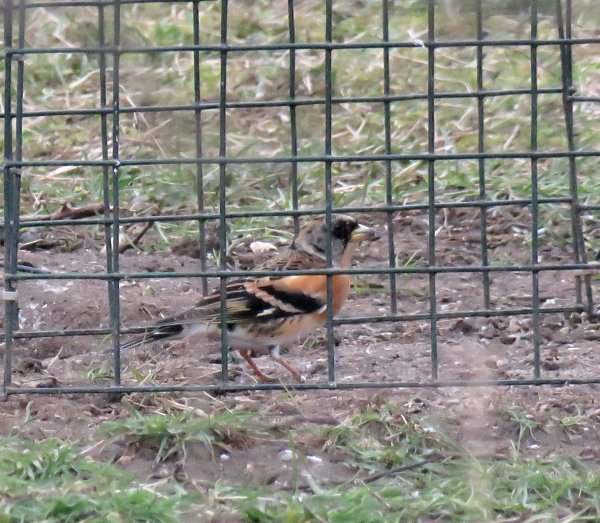 |
| One of many Brambling |
We managed to get Glossy Ibis on the year list for the third year running when one dropped in briefly at dusk. It then decamped to Otmoor where it stayed for a while.
 |
| The brief visit of the Glossy Ibis courtesy of Matthew Lloyd |
Spring
Spring started off with a bang with the discovery of a Siberian Chiffchaff loitering by Burgess Field gate. This is the first record of what is currently a subspecies of Chiffchaff for Port Meadow. Fortunately it ended up lingering for quite a while and was much enjoyed.
 |
| Siberian Chiffchaff, courtesy of Joe Tobias |
It was an unusually good spring for Garganey on the Meadow with quite a few records whilst the floods were still with us.
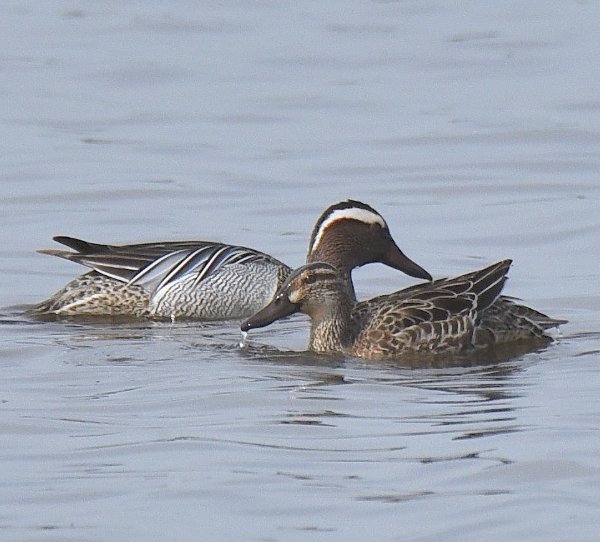 |
| Garganey pair, courtesy of Matthew Lloyd |
As mentioned above, due to the unusually dry spring, the floods were
gone by the start of May which is usually the best time to get some
quality species. Still we managed to get Bar-tailed Godwit and Wood Sandpiper, two of the rarer waders that we might hope to add to the year list. However we ended up missing out on quite a few waders (Sanderling, Whimbrel, Knot and Avocet) that we might reasonably hope to get in a good year.
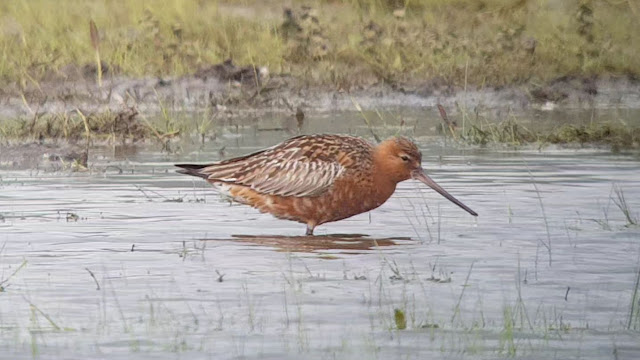 |
| Bar-tailed Godwit, courtesy of Thomas Miller |
Wood Sandpiper
We also scored some stonking spring fly-over ticks with Little Gull and Arctic Tern both seen on the same day.
Summer
Summer is traditionally a quiet season for birding on the Meadow so the sighting of a Little Tern briefly on the the patch was a stand-out record. This was almost certainly the Farmoor bird popping over the hill for a visit but at only the second record ever on the patch it is a really great record. It's just a shame that only one observer saw it.
We were also entertained by a family of Little Owls in the summer which showed well at dusk for quite a number of days before dispersing.
 |
| Little Owl, courtesy of Joe Tobias |
Of course, as the birding slows down, summer is traditionally the time for insects and we had a very good season in that respect. We started off with a Club-tailed Dragonfly photographed along the Thames. This is a rare dragonfly in this part of the river with not many records at all.
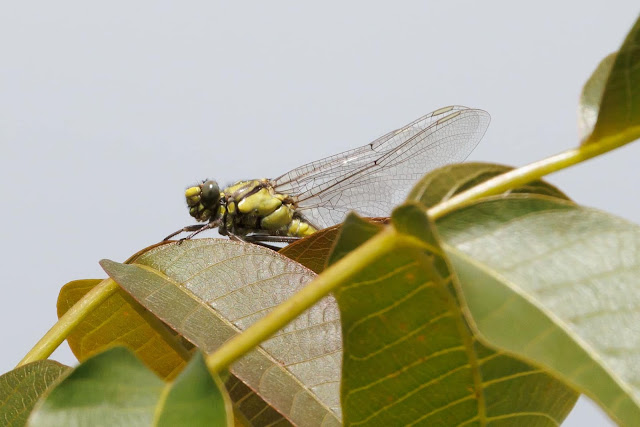 |
| Club-tailed Dragonfly courtesy of Michael Enticott |
Our new Downy Emerlad colony seems well established now with several seen in the Trap Grounds on the main pond. The same can also be said of our Willow Emerald population with plenty of sightings around the various Trap Ground ponds.
 |
| Willow Emerald |
We also had a new colonist this year with a population of Small Red-eyed Damselflies seen in good numbers. Let's hope they become regulars as well.
 |
| Small Red-eyed Damselfly |
Once again we managed one or two sightings of Brown Hairstreak thanks to the eagle eyes of Nicola Devine. Sadly Nicola is no longer with us, having died this year. We will all miss her wonderful photos and great enthusiasm for the Trap Grounds.
 |
| Brown Hairstreak, courtesy of Nicola Devine |
Once again we had some Glow Worm sightings in Burgess Field in the summer.
 |
| Burgess Field Glow Worm, courtesy of Zichen Zhou |
Autumn
Whereas spring was somewhat disappointing, we ended up having a very good autumn. There were unusually good numbers of Spotted Flycatchers and Redstart within Burgess Field this autumn which made for great birding.
 |
| Burgess Field Spotted Flycatcher (one of nine seen this autumn) |
 |
| One of the Four Redstarts seen this autumn |
 |
| This flyover Osprey in Wolvercote made for a great photo, courtesy of Joe Taylor |
Despite the complete lack of flood waters the grassy plains of Port Meadow attracted some good birds this autumn. We had a Grey Plover grace the area for several days.
 |
| The Grey Plover (courtesy of Ben Sheldon) hung around for a while, |
On the Pipit front it was a stand-out autumn. A Rock Pipit was found in the Hinterland area north of the dried up floods. This only the fourth record for the Meadow with the last two being back in 2010.
 |
| The Rock Pipit, courtesy of Joe Tobias |
Following that we had an even rarer Pipit with a Water Pipit loitering near the returning flood waters. This was probably the Farmoor bird which seemed to navigate between that location, the Meadow and Wytham for a little while. This was only the second record, with the last being in 2007.
 |
| The Water Pipit, courtesy of Steve Lavington |
We also had a Yellow-browed Warbler in the Trap Grounds for one day. This was the first of what proved to be a specacular autumn across the county for the once rare Siberian warbler. Another outstanding record was a flyover Hawfinch seen over the Meadow. The post breeding Cattle Egret colony relocated to a field north of Wytham for several weeks.
 |
| Cattle Egrets near Wytham |
We also had a dark-bellied Brent Goose drop in on the floods for one day.
 |
| Brent Goose, courtesy of Ben Sheldon |
Bird of the Year
Finally it's time to award the Port Meadow Bird of the Year award. This year it was rather difficult as there was no obvious stand-out bird. Below is the short list along with the number of previous records for the Meadow:
Siberian Chiffchaff (first record)
Little Tern (second record)
Arctic Tern (first record for several years)
Water Pipit (second record)
Rock Pipit (fourth record)
Yellow-browed Warbler (fourth record)
Hawfinch (second record)
Some of these contenders (e.g. Little Tern and Hawfinch) were single observer records which rather counts against them. The Sibe Chiffy is only a sub-species though still an excellent record. After due consideration I am going to give it to the Water Pipit (which was also a personal patch tick for me). I've long felt that this species should occur more often than it does on the Meadow so it's great finally to have another record.

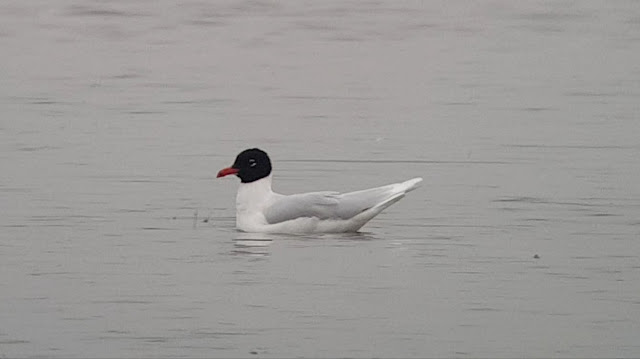
No comments:
Post a Comment